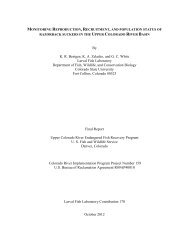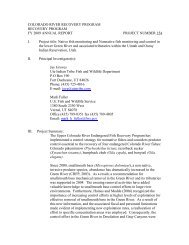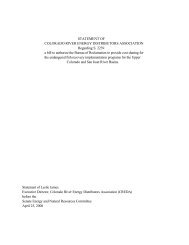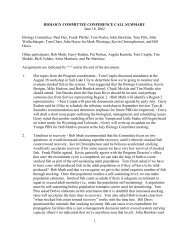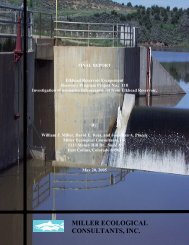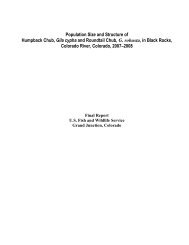riprap - Upper Colorado River Endangered Fish Recovery Program
riprap - Upper Colorado River Endangered Fish Recovery Program
riprap - Upper Colorado River Endangered Fish Recovery Program
Create successful ePaper yourself
Turn your PDF publications into a flip-book with our unique Google optimized e-Paper software.
Flaming Gorge Dam, ameliorates some effects of dam operation on river flow, sedimentload, and temperature (Muth et al. 2000). Holden (1980) concluded that flows from theYampa <strong>River</strong>, especially spring peak flows, were crucial to the maintenance of theGreen <strong>River</strong>’s “large-river” characteristics and, therefore, very important to maintainingsuitable conditions in the Green <strong>River</strong> downstream of the confluence. The Yampa<strong>River</strong> supports resident subadult and adult <strong>Colorado</strong> pikeminnow, contains one of theprimary <strong>Colorado</strong> pikeminnow spawning areas in the <strong>Upper</strong> Basin and is a majorproducer of fish for the entire Green <strong>River</strong> subbasin (Tyus and Karp 1989). A smallpopulation of humpback chub exists in the Yampa <strong>River</strong> in Dinosaur NationalMonument (Tyus and Karp 1989; U.S. <strong>Fish</strong> and Wildlife Service 1990a, 2002a).Spawning aggregations of adult razorback sucker were observed near the mouth of theYampa <strong>River</strong>, and adult razorback sucker were captured upstream to the mouth of theLittle Snake <strong>River</strong> (Tyus and Karp 1989). The lower portion of the Yampa <strong>River</strong> waspart of the historic range of bonytail and is associated with some of the most recentcaptures of this very rare fish. The Bonytail <strong>Recovery</strong> Plan (U.S. <strong>Fish</strong> and WildlifeService 1990b) identified the Yampa <strong>River</strong> within Dinosaur National Monument as ahigh priority recovery and/or restoration site.The Little Snake <strong>River</strong> provides approximately 28% of the Yampa <strong>River</strong>'s flow and 60%of the Yampa <strong>River</strong>’s sediment supply. The sediment supply of the Little Snake <strong>River</strong> isbelieved to be important to the maintenance of backwater nursery areas utilized byyoung <strong>Colorado</strong> pikeminnow in the Green <strong>River</strong> (Smith and Green 1991). Adult<strong>Colorado</strong> pikeminnow have been captured in the Little Snake <strong>River</strong> upstream to nearBaggs, Wyoming, and humpback chub have been captured in the lower 10 miles of theLittle Snake <strong>River</strong> (U.S. <strong>Fish</strong> and Wildlife Service 2002a, 2002c).3.2.2 <strong>Recovery</strong> Actions<strong>Recovery</strong> actions in the Yampa <strong>River</strong> are focused on control of nonnative fishes andmaintaining and legally protecting the flow regime required to recover the endangeredfishes. To achieve these objectives, the <strong>Recovery</strong> <strong>Program</strong> developed the Yampa<strong>River</strong> Management Plan which identifies management actions necessary to provide andprotect the needs of the endangered fishes while existing depletions for human usecontinue and water resources are developed to serve foreseeable future human needsin the Yampa <strong>River</strong> basin (Roehm 2004). The plan proposed to augment Yampa <strong>River</strong>base flows in accordance with the Yampa <strong>River</strong> flow recommendations (Modde et al.1999). Of thirteen alternatives identified and evaluated in the Plan, enlargement ofElkhead Reservoir provided the most reliable water supply at a moderate cost.Construction of the enlargement is complete and water releases for the endangeredfish began in 2007. The <strong>Program</strong> funded a 5,000 af pool of permanent storage out ofthe 12,000 af Elkhead enlargement and may lease up to an additional 2,000 af on anas-needed basis.17




